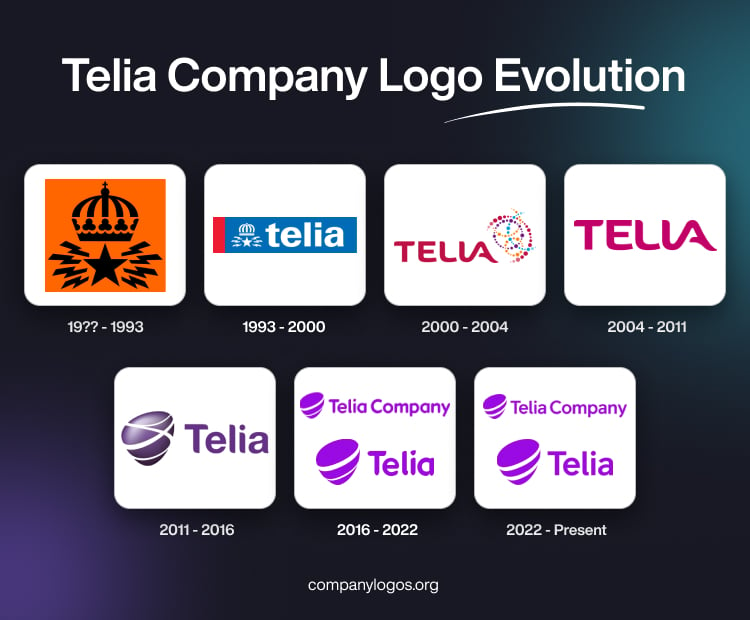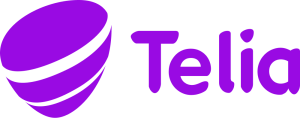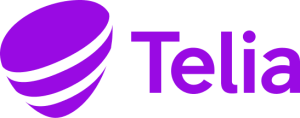
Telia Company is a leading digital communications provider across the Nordic and Baltic regions. Its roots can be traced back to 1853 with the establishment of the Royal Electric Telegraph Agency (Telegrafverket) in Sweden. For over a century, the company operated as a state-owned telecommunications provider. It was only in 1993 that Telegrafverket was corporatised and renamed Telia.
This marked the company’s transition into a modern and competitive telecom operator. The logo of the company has evolved over a period of time and chronicles the journey of the company. The article deals with the evolution of the Telia Company logo since its inception, among other details.
The Genesis of the Telia Company Logo (19?? – 1993)
The original logo of the Televerket company, the predecessor of Telia, featured an ornate crown in black with a rounded top and a flat bottom. Beneath the crown appeared a 5-pointed star in black surrounded by 8 short and thick zigzag lines (4 on each side) symbolising the transmission of signals. The whole logo elements were enclosed within an orange square.

(1993 – 2000)
In 1993, Televerket gave way to Telia, thereby necessitating a logo change. The new logo carried the old logo design in white and added the wordmark “telia” in bold, white lowercase. These were enclosed within a horizontally oriented rectangle in deep blue with a small red band to the left.

(2000 – 2004)
The 2000 logo iteration was part of a rebranding of the company. Designed by Interbrand, the new logo featured the wordmark “TELIA” to the left and several pulsating dotted circles in various sizes and colours. The wordmark “TELIA” was written in a customised serif typeface in maroon colour. The bottom part of the letters “E” and “L” were slightly bent, while “L” and “A” were fused together. The dotted circles conveyed the movement and paths for communication.

(2004 – 2011)
The 2004 logo iteration removed the pulsating dotted circles but retained the style of the wordmark. However, the colour was changed to magenta.

(2011 – 2016)
Another rebranding occurred in 2011 when TeliaSonera introduced the now-iconic purple pebble logo, designed by Landor Associates. The pebble-shaped emblem symbolised “connection,” “innovation,” and an approachable, modern business identity. The bold purple colour of the logo set it apart from its blue and red branded competitors.

(2016 – 2022)
In 2016, TeliaSonera changed its name to Telia Company and presented an updated brand profile. Here, Telia Company became the name of the parent company, while Telia became the consumer-facing brand that Telia Company began using to sell its services. Interestingly, both brands (Telia Company and Telia) were updated with new logo variants.
Designed by Wolff Olins, the updated design of the pebble emblem in both the logo variants gave it a more layered, three-dimensional, and “liquid-like” appearance in violet. The refreshed identity aimed to project Telia as a digital pioneer.


(2022 – Present)
The latest iterations for both brands (Telia Company and Telia) retain the previous design and its colour palette. The only change has been made to the style of the wordmark(s). The letters appear thinner, and the ends of their horizontal bars are shown with straight vertical cuts, instead of being slightly rounded and pointed as earlier. The latest logo variants have been designed to accommodate omnichannel marketing and digital-native environments.


The Elements of the Telia Company Logo
Font
The Telia Company logo uses a custom-designed, bold sans-serif font, which is clean, geometric, and highly readable. The font ensures the brand’s name remains distinct and clear across all digital and physical formats. Besides, the bold and soft contours complement the logo’s pebble symbol.
Colour
The Telia logo is designed using a vibrant and rich purple colour palette to communicate creativity, innovation, and distinction in a crowded telecommunications market. The colour is distinctly visible in both the pebble icon and the wordmark.
The History of Telia Company
The story of the Telia Company begins in 1853 when the Swedish state founded the Kungl. Telegrafverket, or the Royal Telegraph Agency. It thus launched the country’s first electric telegraph line between Stockholm and Uppsala. Over the following decades, Telegrafverket secured a monopoly on telecommunications in Sweden. It controlled both long-distance and local telephone networks by the early 20th century.
In 1953, the agency was rebranded as Televerket, and it went about modernising Sweden’s telecom infrastructure. It introduced automatic telephone exchanges and was a pioneer in mobile telephony. It also played a key role in developing the Nordic Mobile Telephony (NMT) standard during the 1980s. With emerging competition in mobile phones and internet access starting in the 1980s and 1990s, the state monopoly began to erode.
The early 1990s marked a significant turning point. For instance, in 1992–93, Televerket was corporatised and split. Consequently, the regulatory functions were transferred to the Swedish Post and Telecom Authority (PTS), while the operational business was transformed into the government-owned company Telia AB. This shift was part of Sweden’s broader telecom market liberalisation.
In 2000, Telia was partially privatised and listed on the Stockholm Stock Exchange to reflect Sweden’s move towards a competitive market. Two years later, in 2002, a major milestone was reached when Telia merged with Sonera, the leading operator in Finland, to create TeliaSonera. This merger expanded the company’s footprint far beyond Sweden and Finland. It led to the increased presence of the entity in Baltic countries and some Eurasian markets.
The merged entity retained local branding for some time but gradually unified the brand identity. However, the company faced challenges in the 2010s, such as regulatory issues and corruption scandals in certain Eurasian markets. These led to divestments and a renewed focus on its core Nordic and Baltic operations.
In 2016, the company was renamed Telia Company to reflect its strategic refocusing and a contemporary digital vision. Thereafter, it made technological leaps, such as launching Sweden’s first 5G network in collaboration with Ericsson in 2018. It also committed itself strongly to sustainability by powering its networks with renewable energy and earning recognition for its environmental and ethical standards. More recently, in 2025, Telia sold its TV & Media business to Schibsted Media to concentrate on telecommunications and digital services.
The Telia Company is based in Solna, Stockholm, and serves some 25 million customers across Sweden, Finland, Norway, Denmark, Estonia, Latvia, and Lithuania. The company employs around 16,000 to 20,800 people and remains largely controlled by the Swedish state, which retains nearly 40% ownership. Since its inception, Telia has been known for pioneering technological advancements. These began with the telegraph, evolving through fixed-line telephony, mobile networks such as NMT and GSM, and now 5G.
The privatisation and liberalisation of Sweden’s telecom markets transformed Telia from a state monopoly into a competitive corporate entity. Over time, strategic divestments and market withdrawals have helped it focus on digital and telecom services in Northern Europe. The company is also recognised for leading sustainability efforts in its region and has recently embarked on organisational restructuring and climate transition initiatives to prepare for a digital and environmentally responsible future.
Interesting Facts About the Telia Company
- Telia Company was formed after a merger between Sweden’s Telia and Finland’s Sonera in 2002. The combined entity was initially called TeliaSonera.
- Telia traces its roots back to 1853, when the first telegraph network was introduced in Sweden.
- Telia is a dominant player in Sweden, Finland, Norway, Denmark, Estonia, and Lithuania. It offers mobile, broadband, TV, and IT services.
- Telia was among the first telecom companies in Europe to launch commercial 5G services, starting with Finland in 2019.
- Recently, Telia has exited several Eurasian markets, which include Kazakhstan and Uzbekistan, to focus on its core Nordic-Baltic regions.
- Telia is a key enabler of IoT (Internet of Things) technologies. It supports smart city solutions, connected vehicles, and remote monitoring.
- Telia is one of the top digital TV providers in Sweden, with its acquisition of Bonnier Broadcasting in 2019 (owner of TV4, C More, and MTV Finland).
- Telia aims to be a carbon-neutral company across its entire value chain by 2030. It has already achieved climate neutrality in its operations in Sweden and Finland.
- It was one of the first telecom operators to issue green bonds. It did so by using the funds for sustainable infrastructure and energy efficiency projects.
- Telia emphasises gender equality and inclusive leadership and aims for equal gender representation in senior roles.
- The Swedish government owns about 37% of Telia, thereby making it a significant stakeholder.
- Telia Company is listed on the NASDAQ Stockholm and forms part of the OMX Stockholm 30 Index.
Finally
The evolution of the Telia Company logo is a story of continual adaptation. It started with classic state insignias and adapted to futuristic digital forms. The branding captures significant milestones in the company’s and the region’s telecommunications history. The Telia Company logo symbolises the ambition of the company to be at the forefront of digital society.